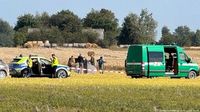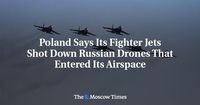On the night of September 9, 2025, a dramatic escalation unfolded over Eastern Europe as Russian drones, launched as part of a massive aerial assault on Ukraine, repeatedly breached Polish airspace. The incident, which Polish Prime Minister Donald Tusk described as "the closest we have been to open conflict since World War Two," has sent shockwaves through NATO, the European Union, and capitals across the continent, raising urgent questions about the risks of spillover from the ongoing war in Ukraine.
According to the BBC and Anadolu Agency, Russia initiated a large-scale strike targeting Ukraine's military-industrial complex in the western regions of Ivano-Frankivsk, Khmelnytskyi, and Zhytomyr, as well as in the cities of Vinnytsia and Lviv. The Russian Defense Ministry claimed its attacks were aimed at Ukrainian defense industry facilities involved in the production and repair of armored vehicles, aviation equipment, and drones. Among the facilities hit were the Lviv Armored Vehicle Plant and the Lvov Aviation Factory LDARZ. "The objectives of the strike have been achieved. All designated targets have been struck," the ministry stated.
But as the barrage unfolded, at least three—possibly four—Russian drones violated Polish airspace and were shot down by a combination of Polish and NATO aircraft, including F-35 and F-16 jets, as well as helicopters. The Polish military tracked a total of 19 drone incursions, prompting the temporary closure of four airports, including Warsaw's main Chopin hub. Flights were diverted to other cities such as Gdansk, Katowice, Wroclaw, Poznan, and even Copenhagen, and authorities warned passengers to expect delays throughout the day.
Prime Minister Tusk, addressing lawmakers on September 10, stressed the gravity of the situation: "This situation brings us the closest we have been to open conflict since World War Two." He acknowledged that, while there was no information suggesting injuries or fatalities, "a line has been crossed, and it's incomparably more dangerous than before." The Polish government quickly invoked Article 4 of the NATO treaty, formally requesting urgent consultations among alliance members—a rare move that signals heightened concern over the security of the alliance's eastern flank.
In the aftermath, Polish authorities discovered seven drones and the remains of an unidentified object across the country. Five of these were located in Lublin province, which borders Belarus and Ukraine, while two others were found much deeper inside Poland, including one in Łódź province—about 250 kilometers from the Belarusian border—and another near Elbląg in the north. The Polish military urged citizens to avoid touching or approaching any drone debris, warning: "Such elements may pose a threat and contain hazardous materials. They must be thoroughly inspected by the appropriate services."
The unprecedented nature of the incident was not lost on international observers. Ukrainian President Volodymyr Zelensky called the attack "an extremely dangerous precedent for Europe," while Foreign Minister Andrii Sybiha argued that Russian President Vladimir Putin was "continuing to escalate, expanding the war." EU leaders, including German Chancellor Friedrich Merz, condemned the incursion as "reckless" and "aggressive." Merz noted, "Russia has endangered human lives in a state that is a member of NATO and the EU. This reckless action is part of a long chain of provocations." NATO Secretary General Mark Rutte echoed this sentiment, describing Russia's actions as "absolutely reckless, absolutely dangerous," and praised the alliance's "very successful reaction."
Russia, for its part, denied any intention to target Poland. The Defense Ministry insisted, "Targets within Poland’s territory were not planned to be attacked. The maximum flight range of Russian UAVs used in this attack, allegedly crossing into Polish territory, does not exceed 700 km." Moscow expressed readiness to hold consultations with the Polish Ministry of Defense, but also pointedly noted that Warsaw had not provided evidence that the drones were of Russian origin. Russia's top diplomat in Poland, Andrei Ordash, claimed the drones "were flying from the direction of Ukraine." The Kremlin, meanwhile, refused to comment directly, with spokesman Dmitry Peskov stating, "This is not our responsibility—it is the prerogative of the Defense Ministry."
Belarus, a close Russian ally, added another layer of complexity by suggesting that the drones entered Polish airspace accidentally after their navigation systems were jammed. Yet, Polish Foreign Minister Radoslaw Sikorski dismissed the notion of an accident, declaring, "We have no doubt that this was not an accidental event... We are dealing with an unprecedented case of an attack not only on Poland's territory but also on the territory of NATO and the European Union." Sikorski further warned that the mass use of drones threatened all of NATO, and called on the alliance to provide Poland with stronger air defense.
The scale of the Russian aerial attack was staggering. According to Ukrainian air force reports cited by DW and BBC, more than 400 drones and 42 cruise missiles were launched just before midnight, with the bombardment lasting throughout the night. Ukrainian air defenses intercepted or jammed 386 drones and 27 cruise missiles, but the sheer volume of the assault underscored the intensity of the conflict and the risks of unintended escalation.
The incident in Poland is not entirely without precedent. Other NATO members—Latvia, Lithuania, and Romania—have reported similar drone incursions and crashes on their territory since Russia's full-scale invasion of Ukraine in 2022. However, this is the first time Russian drones have been downed over a NATO country since the war began, making the episode especially alarming for policymakers and citizens alike.
Germany, which has recently overtaken the US as Ukraine's largest military supporter, quickly backed Poland's invocation of Article 4. German Defense Minister Boris Pistorius told the Bundestag that the drones were "clearly armed" and highlighted the seriousness of the incident. German government spokesman Sebastian Hille remarked, "The violation once again shows the threat that we face and how much Germany and other NATO countries are being tested by Russia."
Within Poland, the mood is a mix of resolve and anxiety. President Karol Nawrocki emphasized, "The security of our homeland is our highest priority and requires close cooperation." Prime Minister Tusk, while careful to avoid panic, did not downplay the stakes: "I have no reason to claim we're on the brink of war, but a line has been crossed." Polish MEP Michał Kobosko, speaking to DW, called the incident "a red alert sent to all of us in Europe, not only the eastern flank." Italian MEP Brando Benefei added, "We should not underestimate and not take a light approach. In terms of the threats that come from Russia—they are real."
As investigations continue and NATO allies confer on next steps, the events of September 9-10, 2025, stand as a stark reminder of the war’s unpredictable reach. For many in Poland and across Europe, the incursion has transformed abstract fears of escalation into a concrete, urgent challenge—one that tests the unity and resolve of the Western alliance in the face of an emboldened Russia.





